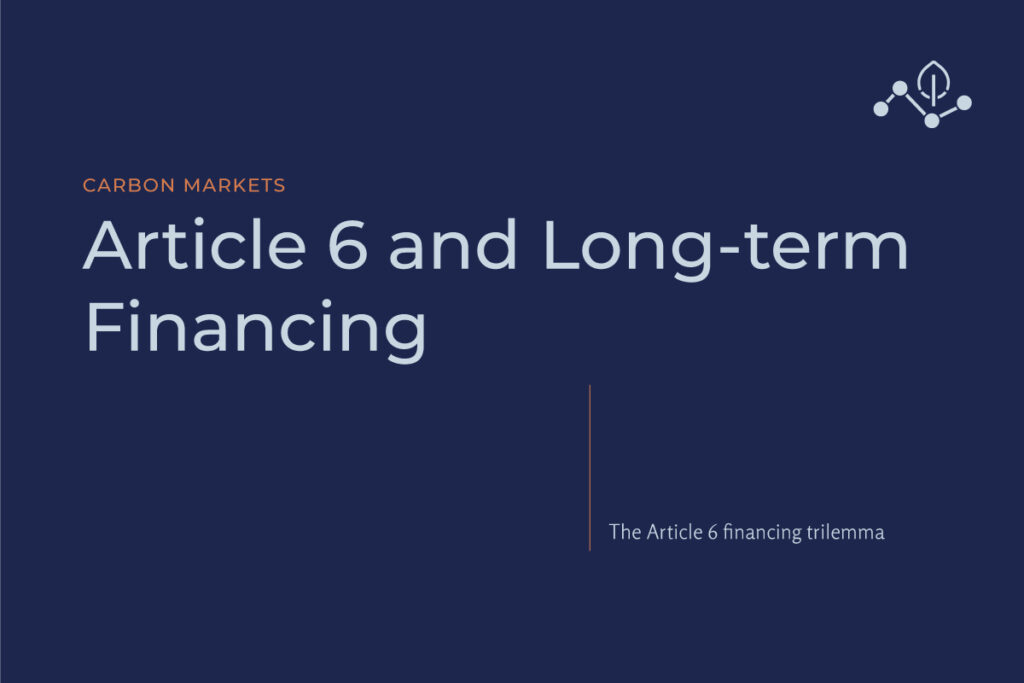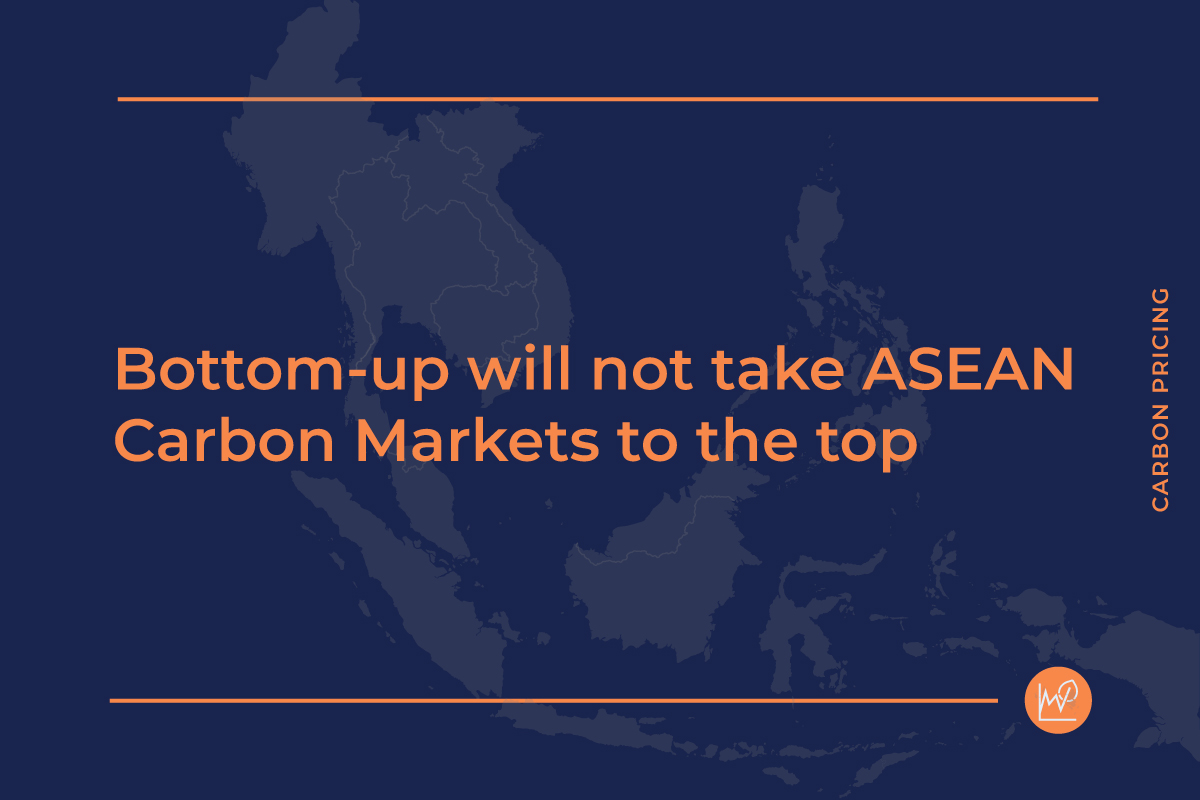Policy Note
Policy note produced for GIZ on Longterm Article 6 participation: Strategies for NDC and SDG Finance
Transcript of presentation
Sustainable Development in International Agreements
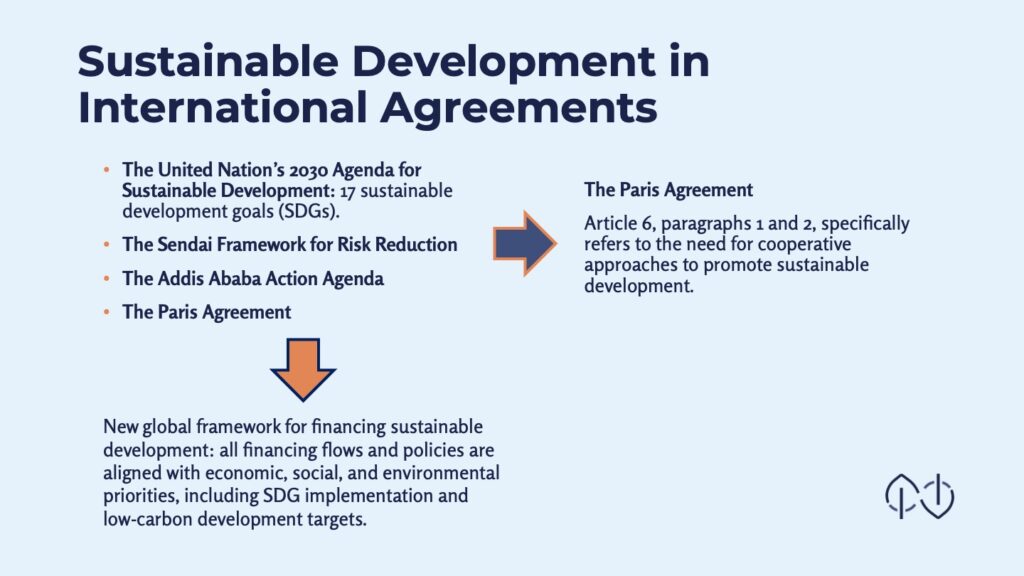
In this presentation we’re going to look at Article 6 and long-term financing. In particular, the prioritization of Article 6 activities that contribute to long-term climate goals and the mobilization of SDG finance.
The link between Article 6 and sustainable development is clearly laid out in the Paris Agreement. That’s in Article 6, paragraphs one and two. So this together with the 2030 agenda and the 17 Sustainable Development Goals, which were adopted simultaneously with the Sendai Framework for Risk Reduction, the Addis Ababa Action Agenda and the Paris Agreement are part of what we call the new global framework for financing sustainable development.
And similarly, Article 6 refers to the corporation among countries contributing to the Paris Agreement goals.
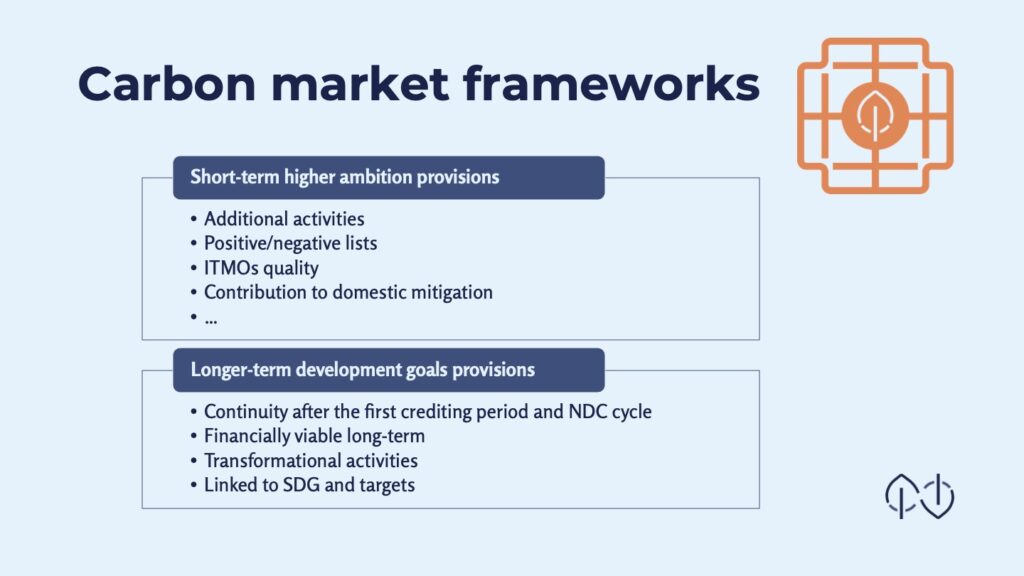
Carbon market frameworks
So, if we look at the carbon market frameworks, while the connection between sustainable development / Article 6 and long-term financing and Article 6 are clearly spelled out in the Paris Agreement, if we look at the Article 6 Carbon Market Participation frameworks different countries are developing, it’s not totally evident that these two areas are properly integrated in their development.
They are the short term and the longer term development goals provisions.
The frameworks, tend to focus on short-term higher ambition provisions, and they all consider in one way or another the identification of additional activities. Most of them include positive and negative lists of activity types, provisions to ensure environmental integrity.
They all strive for high quality ITMOs through provisions related to environmental integrity, accounting methodologies, validation / verification conditions.
And some of them also address the need for mitigation activity to contribute to domestic mitigation.
But what we do not observe or what we haven’t observed in these frameworks is the integration of long-term and sustainable development.
And what do we mean by that? What we mean continuity after the first crediting period and the current NDC cycle, that they are financially viable in the longer term they contribute to transformational activities and linked to SDG and targets.
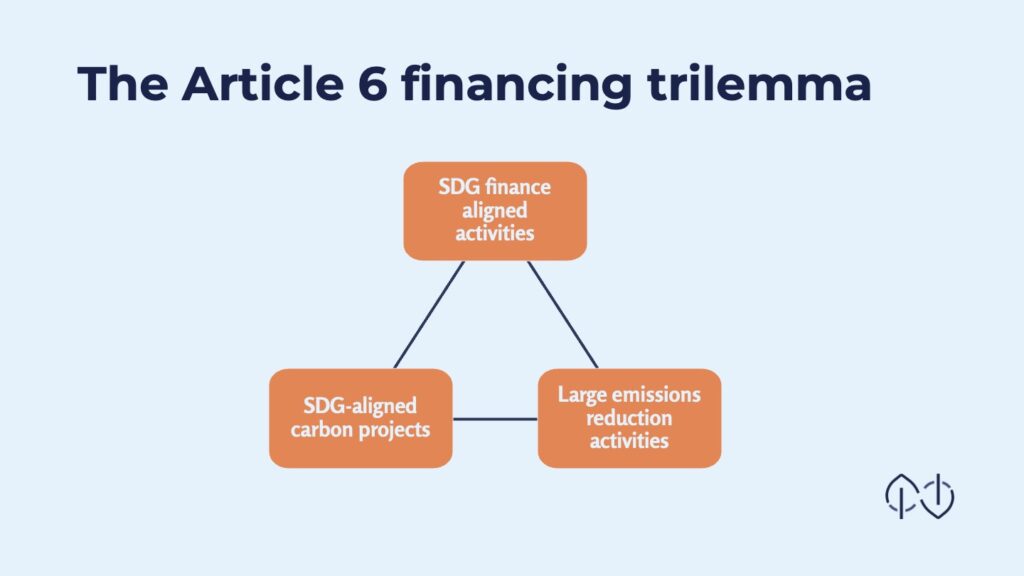
The Article 6 financing trilemma
So that brings us on what we call the “Article 6 financing trilemma” So transformative aligned with SDGs and aligned with raising NDC ambition. This short term focus is the result of, or contributes to exacerbate this idea of what we call the Article 6 financing trilemma.
It is easy to identify large emission reduction activities normally in the energy transport or forestry sectors. These are often too complex and do not always contribute to STGs meaningfully.
Then there are nice SDG aligned carbon projects. Normally these are small in terms of emission reductions, for example, cook stoves, water filters, distributed energy, etc.
Finally, there are good SDG focused projects where we see that emissions reductions are not key.
So the challenge here is to identify large emission reduction projects with meaningful contributions to SDG financing so that they can be transformative.
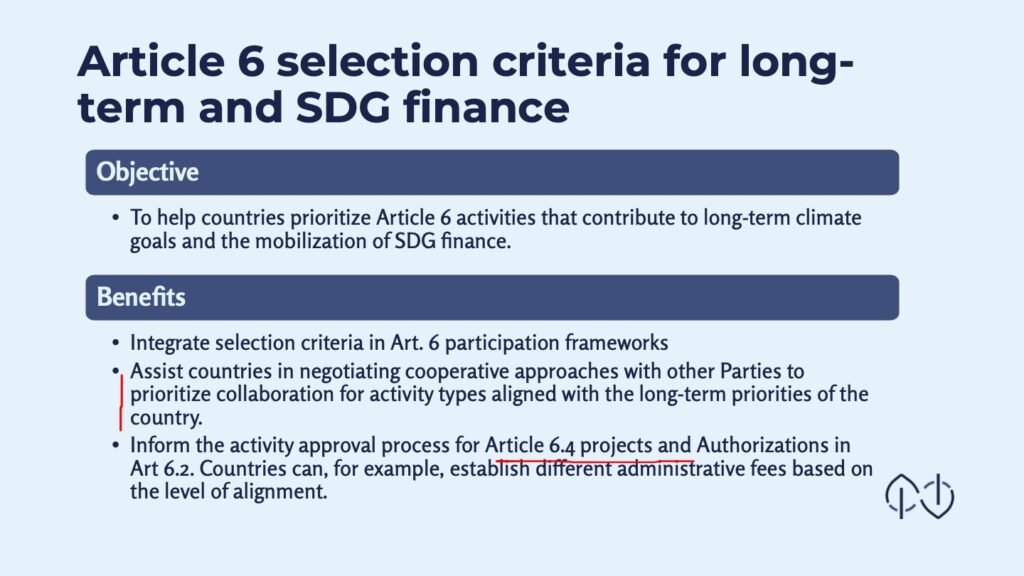
Article 6 selection criteria for long-term and SDG finance
With the objective to assist countries to prioritize Article 6 activities that contribute to long-term climate goals and the mobilization of SDG finance, we have developed a tool for GIZ.
This tool is for countries to use when they decide on mitigation actions to promote through Article 6 and the benefits of that we outline here.
So firstly, it allows to integrate the selection criteria in Article 6 participation frameworks.
It allows to assist countries in negotiating cooperative approaches with other parties to prioritize collaboration activities types aligned with long-term priorities of the country.
And also, can inform the activity approval process for Article 6.4 projects and authorizations in Article 6.2.
Countries can, for example, establish different administrative fees based on the level of alignment.
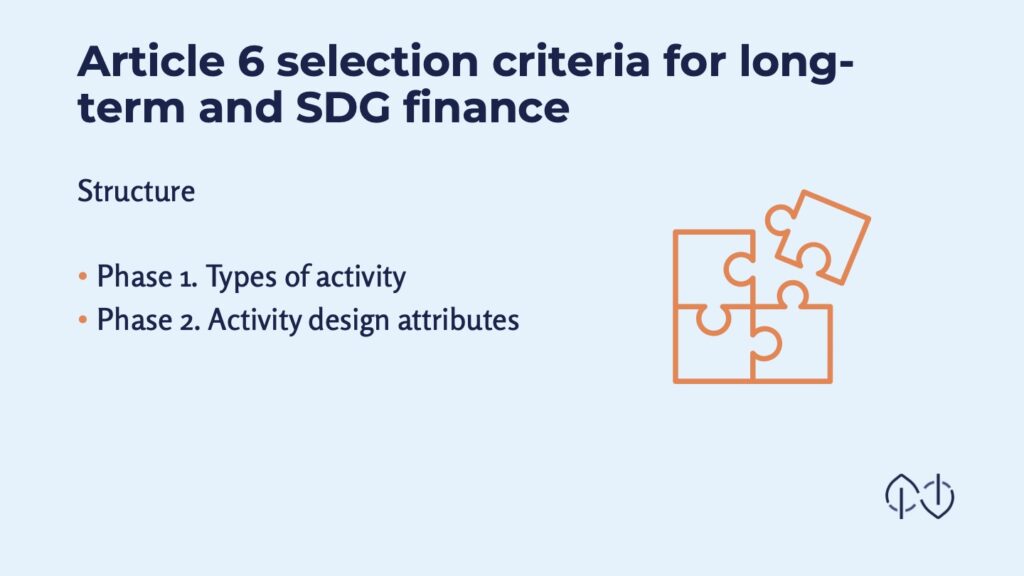
Article 6 selection criteria for long-term and SDG financie
The process for identification of Article 6 activities that contribute to long-term finance goals and the mobilization of SDG finance is proposed in two steps or two phases.
Firstly, a country can analyze what activity types are aligned with those objectives, and secondly, there are some design attributes of a mitigation activity that influence these objectives and therefore should be assessed for the specific activity.
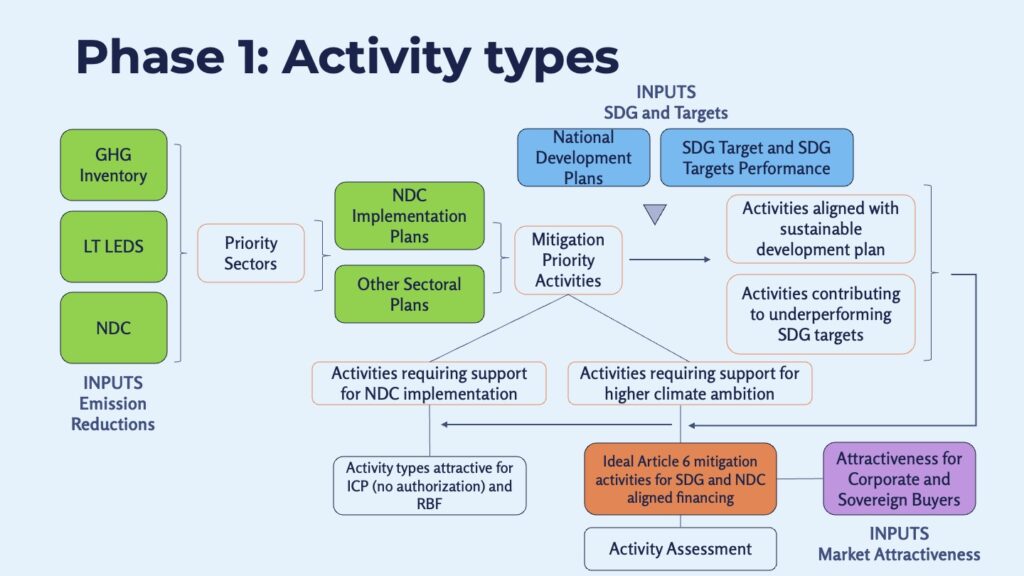
Phase 1 Activity types
Now we’re going to look at these phases in a bit more detail and that’s what we are seeing here.
In this diagram or this this model, we dig into Phase 1, which is the prioritization of the Activity Types.
So first let’s point out there are three inputs, Emissions Reductions, SDG Targets and Market Attractiveness.
The boxes which you’re seeing here outlined in orange are the outputs. First you must identify priority sectors based on what we have here in the green boxes on the left.
These are the emission reduction inputs, that’s GHG inventory, LT-LEDS (long-term low emission development strategies) and NDCs.
And then, we prioritize mitigation activities based on the NDC and other plans.
This would allow us to classify them from the emissions reduction perspective in those that require support for NDC implementation and those which would contribute to increasing the level of ambition.
So now if we add the SDG inputs, we can see of those activities which are attractive from the emissions reduction perspective, those which are aligned with sustainable development plans and which contribute to improving underperforming SDG targets. That’s what we have here in the blue boxes, those are the the inputs.
With this extra input and taking into account the appetite of sovereign buyers, the tool helps us to identify what is in the orange box: the ideal Article 6 mitigation activities for sustainable development and NDC aligned financing.
However, it’s not only about what type of activities, but there are also some activity design attributes to consider, and that’s what we’re going to look at in the next slide in Phase 2.
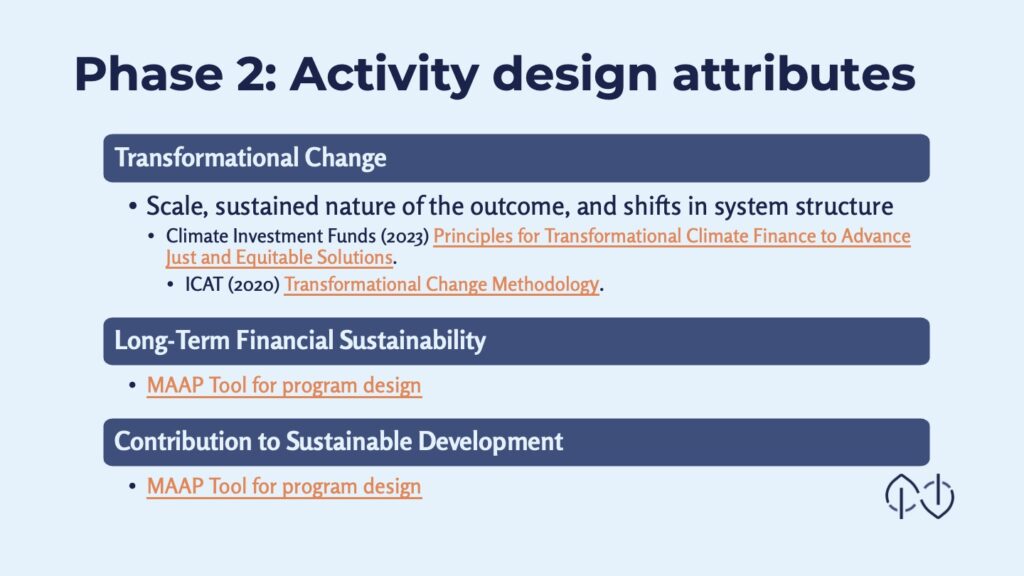
Phase 2: Activity Design attributes
Okay, so the activity design attributes.
This area presents those design attributes to ensure the contribution of activity to long-term climate goals of the country and sustainable development. This is organized into three areas, firstly, transformative impact, secondly, long-term financial sustainability, and thirdly, sustainable development benefits.
The tool has used information from the catalog of criteria provided by GIZ, ICAT Transformational Change Methodology, the Project Assessment Tool developed by UNDP, the program level Mitigation Action Assessment Protocol. (That’s the MAAP tool which was developed by the World Bank) and the UNEP Sustainable Development Assessment template.
Let’s look at these three areas in more detail. So first, Transformational Change. The Transformational Change learning partnership, the TCLP by CIF defines transformational change for climate action as a “fundamental change in systems relevant to climate action with large scale positive impacts that shift and accelerate the trajectory of progress towards climate neutral, inclusive, resilient, and sustainable development pathways”.
There are several resources to assess the transformational change of a mitigation action. In general, it relates to the scale sustained nature of outcome and shifts in system structure.
Secondly, the long-term financial sustainability of the mitigation action is critical to ensure the contribution to finance to climate goals beyond one NDC cycle. And also the contribution to SDGs, what normally require long-term support. It is proposed to use the program level MAAP tool to assess long-term financial sustainability. This tool is designed for assessing comprehensive programs that involve policy and project implementation. Finally, the UNDP MADD assessment tool includes a streamlined approach for single instance projects or programmatic projects.
And then thirdly, the contribution to sustainable development.
So this set of indicators assesses the activity contribution to sustainable development beyond emissions reduction. It is based on the MAAP tool, sustainable development module. It evaluates the planning, implementation, and monitoring aspects of the activity, social environment and financial benefits, and assesses how different stakeholders are considered in the design or implementation of the mitigation action.
So that is the overview of the phase two.
Conclusions
Participation in Article 6 should evolve to promote transformational projects with a long-term perspective. Long-term and SDG finance alignment criteria need to be integrated into the activity selection process as part of Article 6 frameworks, as discussed earlier.
The GIZ selection criteria toolkit builds on previous work by GIZ and draws from other tools, as outlined in the last slide. It proposes a two-phase approach:
- Identification of activity types at the national level.
- Assessment of activities against three criteria: transformational change, long-term sustainability, and contribution to sustainable development goals.
These results will help countries prioritize Article 6 activities that contribute to long-term climate goals.

